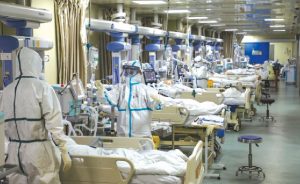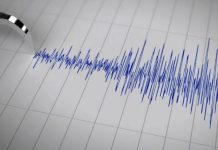 The largest analysis of hospitalized US Covid-19 patients to date finds that most did not survive after being placed on a mechanical ventilator. A report by By Robert Preidt, Health Day reporter has raised a question mark over the treatment methodology for Covid-19 patients.
The largest analysis of hospitalized US Covid-19 patients to date finds that most did not survive after being placed on a mechanical ventilator. A report by By Robert Preidt, Health Day reporter has raised a question mark over the treatment methodology for Covid-19 patients.
The study included the health records of 5,700 Covid-19 patients hospitalized between March 1 and April 4 at facilities overseen by Northwell Health, New York State’s largest health system.
Among the 2,634 patients for whom outcomes were known, the overall death rate was 21 per cent, but it rose to 88 per cent for those who received mechanical ventilation, the Northwell Health Covid-19 Research Consortium reported.
The new findings “provide a crucial early insight into the front-line response to the Covid-19 outbreak in New York,” Dr. Kevin Tracey, president and CEO of the Feinstein Institutes for Medical Research, said in a Northwell Health news release.
The findings also add fuel to the notion that ventilators may sometimes do more harm than good for patients battling for life with severe Covid-19.
Mechanical ventilators work by pushing air into the lungs of critically ill patients who can no longer breathe well on their own. These patients must be sedated and have a tube stuck into their throat.
Recognizing that complications from ventilator use can occur, some intensive care units (ICUs) have started to delay putting a Covid-19 patient on a ventilator until the last possible moment, when it is truly a life-or-death decision, said Dr. Udit Chaddha, an interventional pulmonologist with Mount Sinai Hospital in New York City.
“There had been a tendency earlier on in the crisis for people to put patients on ventilators early, because patients were deteriorating very quickly,” Chaddha said. “That is something that most of us have stepped away from doing.
“We let these patients tolerate a little more hypoxia [oxygen deficiency]. We give them more oxygen. We don’t intubate them until they are truly in respiratory distress,” Chaddha said. “If you do this correctly, if you put somebody on the ventilator when they need to be put on the ventilator and not prematurely, then the ventilator is the only option.”
Ventilators are typically used only when patients are extremely ill, so experts believe that between 40 per cent and 50 per cent of patients die after going on ventilation, regardless of the underlying illness.
These critically ill patients die because they are so sick from Covid-19 that they needed a ventilator to remain alive, not because the ventilator fatally harms them, said Dr. Hassan Khouli, chair of critical care medicine at the Cleveland Clinic in Ohio.
“I think for the most part it’s not related to the ventilator,” Khouli said. “They’re dying on the ventilator and not necessarily dying because of being on a ventilator.”
An 88 per cent death rate is especially high, however. Ventilators do have side effects. Because a machine is breathing for them, patients often experience a weakening of their diaphragm and all the other muscles involved with drawing breath, Chaddha said.
“When all these muscles become weaker, it becomes more difficult for you to breathe on your own when you’re ready to be liberated from the ventilator,” Chaddha said.
These patients also are at risk of ventilator-associated acute lung injury, a condition caused by overinflating the lungs during mechanical ventilation, Khouli said.
Doctors have to precisely calculate the amount of air to push into a person’s lungs with every mechanical breath, taking into account the fact that a large part of the lung could be full of fluid and incapable of inflation. “The amount of volume you need to deliver would be usually less,” he said.
“If the settings are not managed correctly, it can cause an additional trauma to the lungs,” Khouli said.
Ventilated patients also are at increased risk of infection, and many are at risk of psychological complications, Chaddha said. A quarter develop post-traumatic stress disorder, and as many as half might suffer subsequent depression.
“It is not a benign thing,” Chaddha said. “There are a lot of side effects. And the longer they are on a ventilator, the more likely these complications are to happen.”
Besides the statistics on ventilated patients, the New York study also pointed to several factors that contribute to more severe illness in Covid-19 patients.
Gender seemed to matter: Most of the patients were male, and the median age was 63. The death rate was higher for males than females.
The researchers also found that high blood pressure (57 per cent), obesity (41 per cent) and diabetes (34 per cent) were the most common types of co-existing health problems in Covid-19 patients.
Patients with diabetes were more likely to receive invasive mechanical ventilation, receive treatment in the ICU, or develop acute kidney disease, the findings showed.
Of the patients whose outcomes were known, 14 per cent were treated in the ICU, 12 per cent required invasive mechanical ventilation, and 3 per cent received kidney replacement therapy.
When initially assessed, about one-third of patients had a fever, nearly a thousand had a high respiratory rate and almost 1,600 received supplemental oxygen. On average, patients were discharged after four days.
The study, published online April 22 in the Journal of the American Medical Association, was conducted by the Northwell Health Covid-19 Research Consortium, with support from the Feinstein Institutes for Medical Research.
“New York has become the epicenter of this epidemic. Clinicians, scientists, statisticians and laboratory professionals are working tirelessly to provide best care and comfort to the thousands of Covid-19 patients in our Northwell hospitals,” said Karina Davidson, professor and senior vice president at the Feinstein Institutes.
“Through our consortium, we will share our clinical and scientific insights as we evolve the ways to care for and treat Covid-19 patients,” Davidson noted.
Tracey added that “these observational studies and other randomized clinical trial results from the Feinstein Institutes will improve the care for others confronting Covid outbreaks.”
The New York City emergency-medicine physician Dr. Cameron Kyle-Sidell too had sparked controversy when, he posted a YouTube video claiming that ventilators may be harming Covid-19 patients more than they’re helping. He warned, “We are operating under a medical paradigm that is untrue. I believe we are treating the wrong disease, and I fear that this misguided treatment will lead to a tremendous amount of harm to a great number of people in a very short time.”
Health care experts point out that mechanical ventilation always comes with risks: a tube must be placed into a patient’s airway to deliver oxygen to their body when their lungs no longer can. It’s an invasive form of support, and most doctors view it as a last resort.
The medical spokesperson for the American Lung Association, Dr. David Hill says arguments against Covid-19 ventilation have been over-simplified. It may be less that ventilators aren’t the proper treatment for coronavirus, and more that they’re not a panacea for a pandemic that has pushed the health care system to its breaking point. He says, “High ventilator mortality rates suggest a health care system failing, and not a ventilator hurting people”.
letters@tehelka.com













